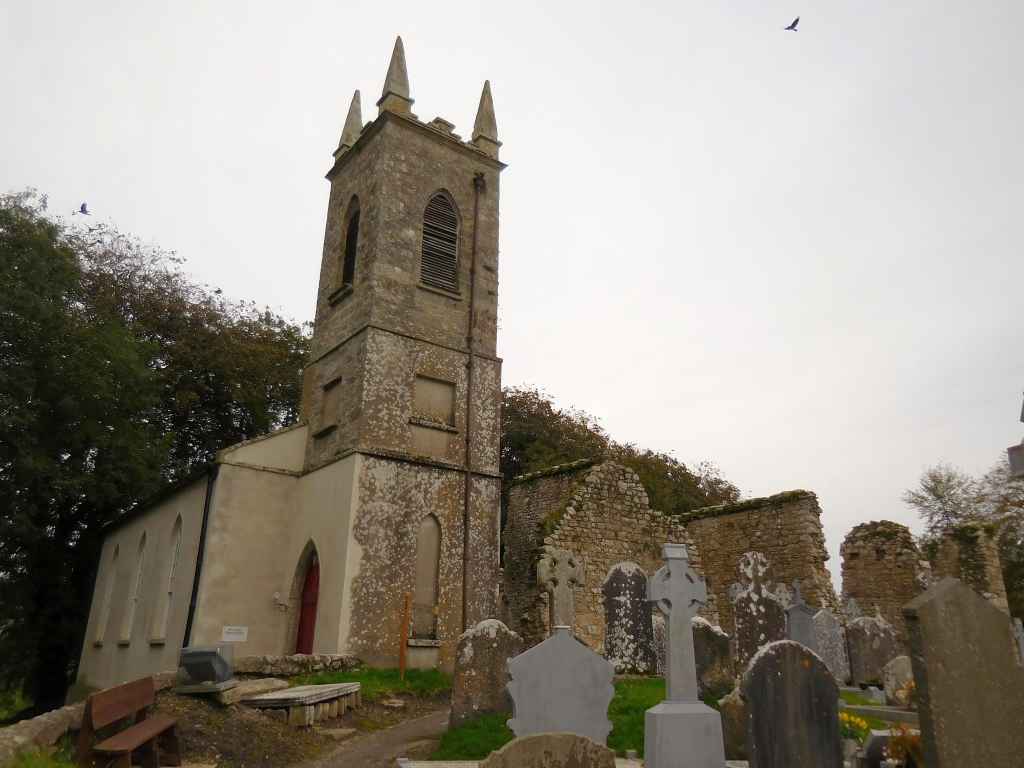Kirche zum Hl. Mullins / St. Mullins Church
Der Hl. Mullins (auch Moling genannt) erbaute mit Hilfe seines Lehrmeistes Aiden von Ferns im 7. Jahrhundert ein Kloster (Tigh Moling - Haus des Moling) südlich von Graiguenamanagh. Der Heilige starb 697 und ist auch hier begraben. Ende des 10. Jahrhunderts von den Wikingern geplündert, wurde das Kloster 1138 abermals niedergebrannt. Im 15. Jahrhundert wurden neue Gebäude errichtet, zum Teil über die Ruinen des alten Klosters. Wie die protestantische Kirche aus dem frühen 19. Jahrhundert, die heute aufgelassen ist und als Kulturerbezentrum dient.
In the 7th century St. Mullins (a.k.a. Moling) - with the help of his mentor Aiden of Ferns - built a monastery (Tigh Moling - house of Moling) south of Graiguenamanagh. The saint died in 697 and is buried here. Plundered by the Vikings at the end of the 10th century, the monastery was burnt down again in 1138. During the 15th century new buildings were erected, partially over the ruins of the old monastery. Like the protestant church built in the early 19th century, which today is disused as church and reused as heritage centre.
Kirche zum Hl. Mullins im Detail / Expand on St. Mullins Church
 Kirche aus 15. JH / Church from 15th century
Kirche aus 15. JH / Church from 15th century Hochkreuz / High Cross
Hochkreuz / High Cross St. Mullins Abtei / St. Mullin's Abbey
St. Mullins Abtei / St. Mullin's Abbey Rundturm / Round Tower
Rundturm / Round Tower St. Jakobs Zelle / St. James's Cell
St. Jakobs Zelle / St. James's Cell Wirtschaftsgebäude / Domestic Building
Wirtschaftsgebäude / Domestic Building Gebetshaus / Oratory
Gebetshaus / Oratory Grab von König Art / Grave of King Art
Grab von König Art / Grave of King Art Badehaus / Bathing House
Badehaus / Bathing House Friedhof 1798 Denkmal / Cemetary 1978 Memorial
Friedhof 1798 Denkmal / Cemetary 1978 Memorial St. Molins Mühle / St. Molin's Mill
St. Molins Mühle / St. Molin's Mill Normannische Motte / Norman Motte
Normannische Motte / Norman Motte
Zugeordnete Themen / Assigned Topics:
Mehr Informationen über - Kirche zum Hl. Mullins / More information about - St. Mullins Church
 stmullinsheritagecentre.com/
stmullinsheritagecentre.com/  Wikipedia (en): St. Mullin's Church
Wikipedia (en): St. Mullin's Church  www.askaboutireland.ie/reading-room/history-heritage/folklore-of-ireland/carlow-folklore/st-moling/st-mullins-ancient-site/
www.askaboutireland.ie/reading-room/history-heritage/folklore-of-ireland/carlow-folklore/st-moling/st-mullins-ancient-site/  www.buildingsofireland.ie/buildings-search/building/10302605/saint-mullins-church-of-ireland-church-st-mullins-county-carlow
www.buildingsofireland.ie/buildings-search/building/10302605/saint-mullins-church-of-ireland-church-st-mullins-county-carlow  www.discoverireland.ie/Arts-Culture-Heritage/st-mullins-ecclesiastical-village/71019
www.discoverireland.ie/Arts-Culture-Heritage/st-mullins-ecclesiastical-village/71019  www.megalithicireland.com/St%20Mullins%20Monastic%20Site.html
www.megalithicireland.com/St%20Mullins%20Monastic%20Site.html  www.riverbarrow.net/st.-mullins.html
www.riverbarrow.net/st.-mullins.html
Lage / Location
Irish grid: S 72835 38010







